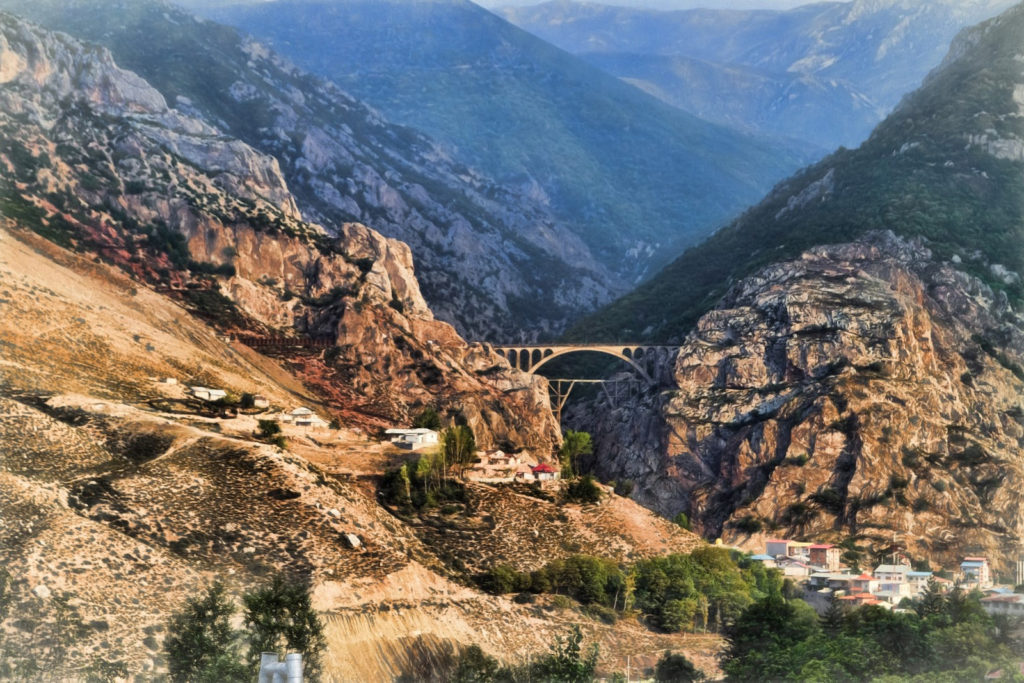Bridges are a very symbolic and effective form of infrastructure. They represent connection, progress, and accessibility. The Middle East has a number of remarkable bridges, but Iran has truly set itself apart with the design and multitude of its bridges within the confines of a small country. In the Iranian city of Isfahan alone, 11 bridges cross the Zayandeh River.
Here are six of Iran’s most remarkable bridges, old and new:
-
Pol-e-Tabiat
One of Iran’s newest bridges, Pol-e-Tabiat, opened to visitors and residents of Tehran in 2014. The project was designed and realized by a 26-year-old architect named Leila Araghian. Araghian collaborated with her long-time friend Alireza Behzadi and a group of architects at the Diba Tensile Architecture firm to create the Pol-e-Tabiat, which is also called the Nature Bridge.
Pol-e-Tabiat stretches almost 900 feet above Tehran’s Modarres Highway. The structure itself is far from typical. Pol-e-Tabiat is a three-story, curved structure with a level for restaurants, a level for recreation, and a level that acts as a viewing platform. Each of the bridge’s three pathways is made from composite wood that can be recycled.
Construction lasted four years and required over 30,000 cubic feet of concrete and 4 million pounds of steel. Pol-e-Tabiat has won several awards and been praised as a new icon for the city of Tehran.
-
Si-o-se Pol, Isfahan, Iran
The longest of Isfahan’s 11 bridges crossing the Zayandeh River, Si-o-se Pol is also known as the Bridge of Allahverdi Khan, after the person who constructed it. Si-o-se is the Farsi word for the number 33, which is appropriate for this bridge because it is made up of a collection of 33 arches.

Image by Diego Delso | Flickr
Si-o-se Pol, which is almost a thousand feet long and approximately 45 feet wide, was completed in 1602. It is a two-level structure, with the top level featuring two arches for each one of the 33 arches below. Each of the 34 piers that hold up the bridge are over 11 feet wide. The southern end of Si-o-se Pol houses a tea room.
-
Khaju Bridge, Isfahan, Iran
Another bridge that crosses the Zayandeh River, the Khaju Bridge is similar in appearance to Si-o-se Pol, but it is smaller. With only 23 arches, the Khaju Bridge acts as a connector between neighborhoods on either side of the river, but it also serves the purpose of a dam. The bridge’s damming functions helped to provide nearby communities with water for farming. The lower level of the bridge contains water flow regulators.
The Khaju Bridge was built in 1650 under Shah Abbas II. The bridge, which stretches over 400 feet across the Zayandeh, has a design that includes a pavilion in the center where the Shah used to sit and enjoy the river scenery.
-
Veresk Bridge

Image by Fiction of Reality | Flickr
Unlike the road bridges crossing the Zayandeh River in Isfahan, the Veresk Bridge is a railway bridge. Reaching a height of 360 feet, the Veresk Bridge is the second-tallest railway bridge in the country.
The engineering and construction of the bridge was overseen by an Austrian named Walter Inger, who after his death was buried nearby at his request. After the bridge’s completion in 1936, a steel scaffolding structure was maintained beneath the bridge to simplify renovations in the future.
The Veresk bridge connects the Iranian capital of Tehran with the Caspian Sea. It sees about 4 trains pass over it each day.
-
Lake Urmia Bridge
Lake Urmia is the largest lake in Iran. At nearly a mile long, the Lake Urmia Bridge is part of a larger, 80-mile road project that connects the eastern and western sections of Iran’s Azerbaijan province. Opened to the public in 2008, the Lake Urmia Bridge cost over $100 million and took nearly 30 years to construct.
Some studies show that the construction of the bridge has caused the lake to dry up more quickly. The lake is extremely salty, though, so some of its evaporation may be the natural result of hypersalinity.
-
Persian Gulf Bridge
The intent of the Persian Gulf Bridge is to connect Iran’s largest island, Qeshm Island, to mainland Iran. The road and rail bridge will stretch almost 1.5 miles across the Persian Gulf, starting at the island’s Laft Port and ending in the mainland city of Khamir.
The bridge is expected to stimulate the economic development of Qeshm Island because the railway will be used in part to ship iron ore to the island, where it will be turned into steel. The connectivity provided by the road will also improve Qeshm Island’s potential as a tourist destination.
With a budget of nearly $700 million, construction of the bridge began in 2011 and is yet to be completed. When it is finished, the Persian Gulf Bridge will be the longest in Iran.
These six bridges run the span, not just of water, but of time, demonstrating Iran’s commitment to superior architecture throughout history.

